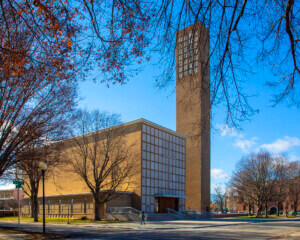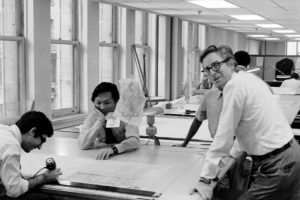The two most daring architects of the middle of the 20th century, Eero Saarinen and Louis Kahn, both went to the Abba Tor when they needed help designing groundbreaking buildings. Saarinen enlisted Tor’s help on the TWA Terminal at JFK Airport, the Deere & Company headquarters, and the Repertory Theater at Lincoln Center. Kahn worked with him on the Yale British Art Center and the Roosevelt Island Four Freedoms Park.
Abba Tor died peacefully of heart and kidney failure, on February 11 at age 93, in Hastings-on-Hudson, where he had lived for the last 50 years. He was born in Warsaw on November 1, 1923, but grew up in Palestine (before Israel became a state). He joined the Israeli underground when he was an engineering student at the Technion, where he met his wife Nomi, who was studying architecture.
He was also involved in the establishment of the Israeli Defense Forces, the unusual co-ed military that aligned the army, navy and air force. The IDF sent him to the United States in 1952 to work with the U.S. Bureau of Standards. While here, he earned a Master’s degree at the Columbia University School of Engineering. His daughter, Shuli, was born in America, too, but the family returned to Israel the next year. Two years later, however, Tor left the military to start his own engineering practice and ended up back in New York where he soon became associated with the firm of Ammann & Whitney. He also taught at the Columbia University School of Architecture and did peer reviews nationally for the Connecticut Society of Engineering, though he went back to Israel in the mid-60s and, using a Danish system, built Carmiel, the first prefabricated housing community in the country.
Abba Tor loved to tell stories about the ways his clients operated. He liked working with architects who pushed boundaries but noted that they did so very differently. Saarinen was a form giver—searching for the appropriate image and experiential feeling for every building. He just wanted the engineer to help him make it stand up. Tor would have to cajole him into logical (or at least practical) solutions. At the TWA Terminal, that meant convincing Saarinen that the entire roof, all 1.4 acres of it, could not be made of one continuous embracing shape. It had to be built in pieces with joints and separations. A single pour would lead to shrinkage—and later to cracks. But there was a benefit to the solution. The joints between the shells created the dramatic three-foot-wide skylights. But it was not easy. The engineer had to follow the architect’s dictates and talk him into sustainable forms.
In 1962, after Saarinen had died, Tor left Ammann & Whitney to form a partnership with Henry Pfisterer, an engineer who had worked with the Saarinen firm on Yale’s Morse and Stiles Colleges and on the North Christian Church in Columbus, Indiana.
Working with Louis Kahn presented different challenges. It was, in a way, more a true partnership since Kahn wanted to understand structural forces at the beginning and develop designs to accommodate them, though his buildings, too, were unique and unprecedented. “Abba Tor was an invaluable partner to Louis Kahn in the design of the Yale Center for British Art helping to structure the most sublime moments of the architecture. Abba rationalized the building and contributed significantly to the resolution of the Center’s interdependent ‘served’ and ‘servant’ spaces,” as George Knight, the New Haven architect who recently renovated the Center, explained.
But even working with Kahn had its challenges. Tor recalled that once, when told that he could not do what he wanted, Kahn had said, “‘You engineers are all the same; you are like sausage cutters!’ I said to him, ‘Lou, we are not sausage cutters, we are more like the male dancers in a classical ballet. Sometimes we jump and soar, and other times we stand there firmly on the stage and when we see the ballerina take the big leap, we catch her in mid-air, we turn her around, and we make sure the she lands gracefully and doesn’t fall on her face.'” (This recollection, from the archives of the National Building Museum, was posted recently in a podcast by architectural photographer Timothy Schenk.)
Even in recent years, as his health failed, Tor traveled when he could and stayed abreast of current events around the world, following newspapers from several continents. He had opinions on everything. He made several appearances in the recent film shown in the Public Broadcasting System’s American Masters series, “Eero Saarinen: The Architect Who Saw the Future” in December.
Abba Tor was predeceased by his wife Nomi and his son Daniel. His daughter, Shuli Tor, survives him.










